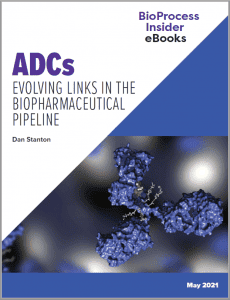Content Spotlight
Podcast: MilliporeSigma says education vital to creating unbreakable chain for sustainability
MilliporeSigma discusses the importance of people, education, and the benefits of embracing discomfort to bolster sustainability efforts.
 Antibody–drug conjugate (ADC) developers both old and new are talking about the next generation of drug candidates coming through their pipelines. In April 2021, Zynlonta (loncastuximab tesirine, from ADC Therapeutics) became the eleventh such product to receive approval from the US Food and Drug Administration (FDA). But with dozens of ADC candidates currently in clinical trials, those 11 products represent the tip of the ADC iceberg. In this eBook, Dan Stanton (founding editor of BioProcess Insider) explores ADC production history, investment records, and regulatory approval patterns. By tracing those elements, Stanton highlights different generations of ADC approaches and then explains how the modality is likely to evolve as interest and investment continue to rise. Read the eBook to learn more about emerging trends in ADC production, including improved linker technologies, novel payloads, and significant decreases in therapy toxicity.
Antibody–drug conjugate (ADC) developers both old and new are talking about the next generation of drug candidates coming through their pipelines. In April 2021, Zynlonta (loncastuximab tesirine, from ADC Therapeutics) became the eleventh such product to receive approval from the US Food and Drug Administration (FDA). But with dozens of ADC candidates currently in clinical trials, those 11 products represent the tip of the ADC iceberg. In this eBook, Dan Stanton (founding editor of BioProcess Insider) explores ADC production history, investment records, and regulatory approval patterns. By tracing those elements, Stanton highlights different generations of ADC approaches and then explains how the modality is likely to evolve as interest and investment continue to rise. Read the eBook to learn more about emerging trends in ADC production, including improved linker technologies, novel payloads, and significant decreases in therapy toxicity.
Fill out the form below to read the eBook now.
New for 2021, the BioProcess Insider quarterly eBook series reports industry perspectives about — and critical analyses of — emerging trends in biopharmaceutical development, manufacturing, and commercialization. Upcoming topics include the production capacity and regulatory hurdles to be negotiated by gene-therapy developers and the COVID-19 pandemic’s long-term effects on vaccine supply chains and investments.
You May Also Like